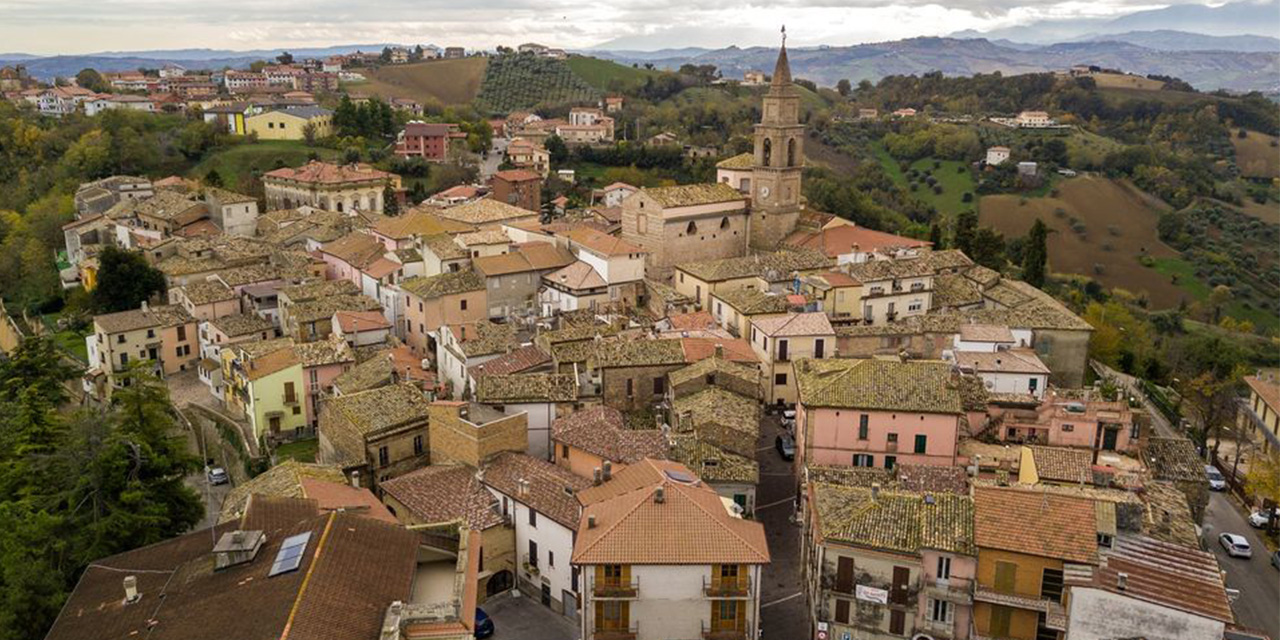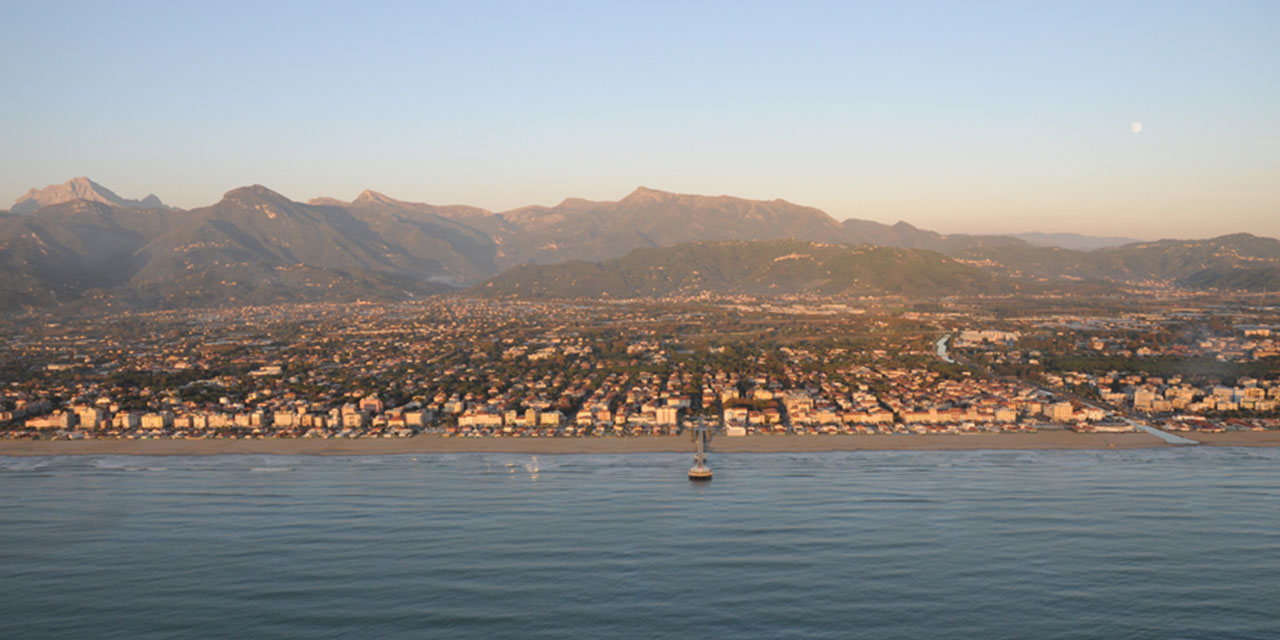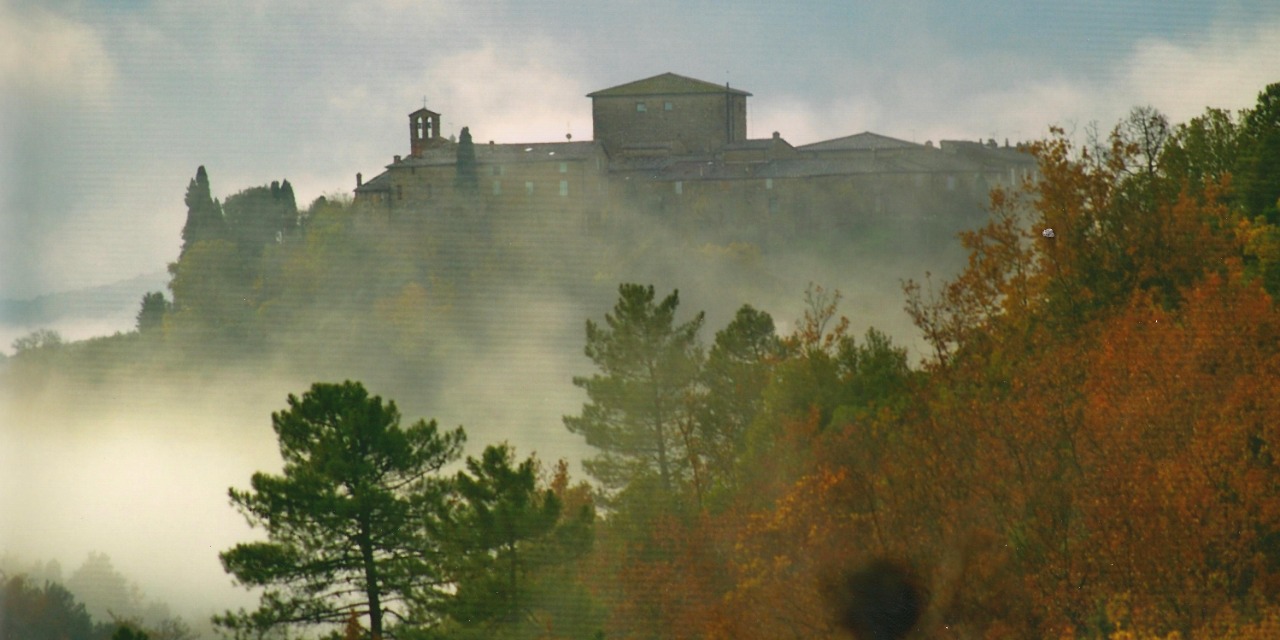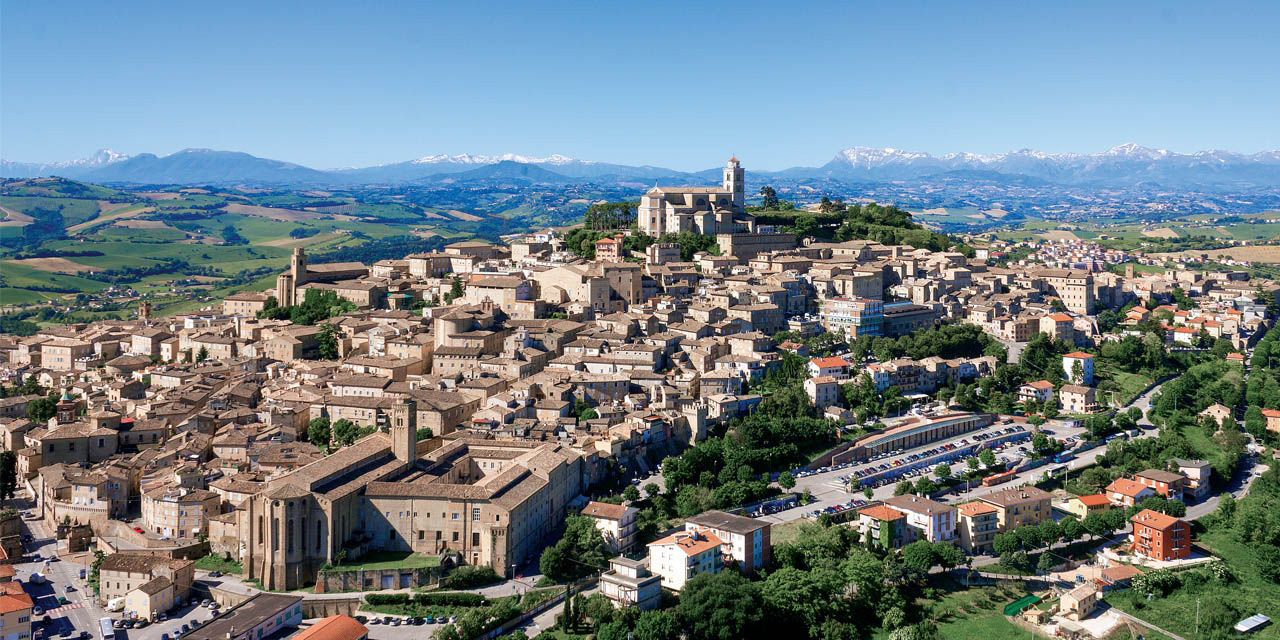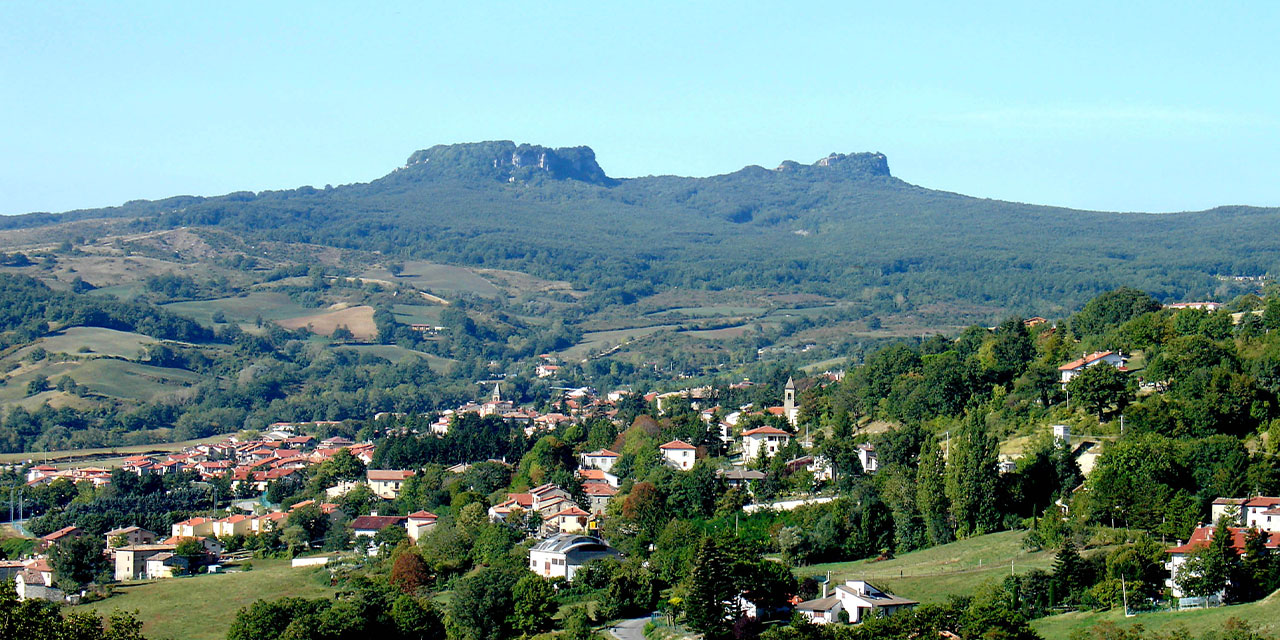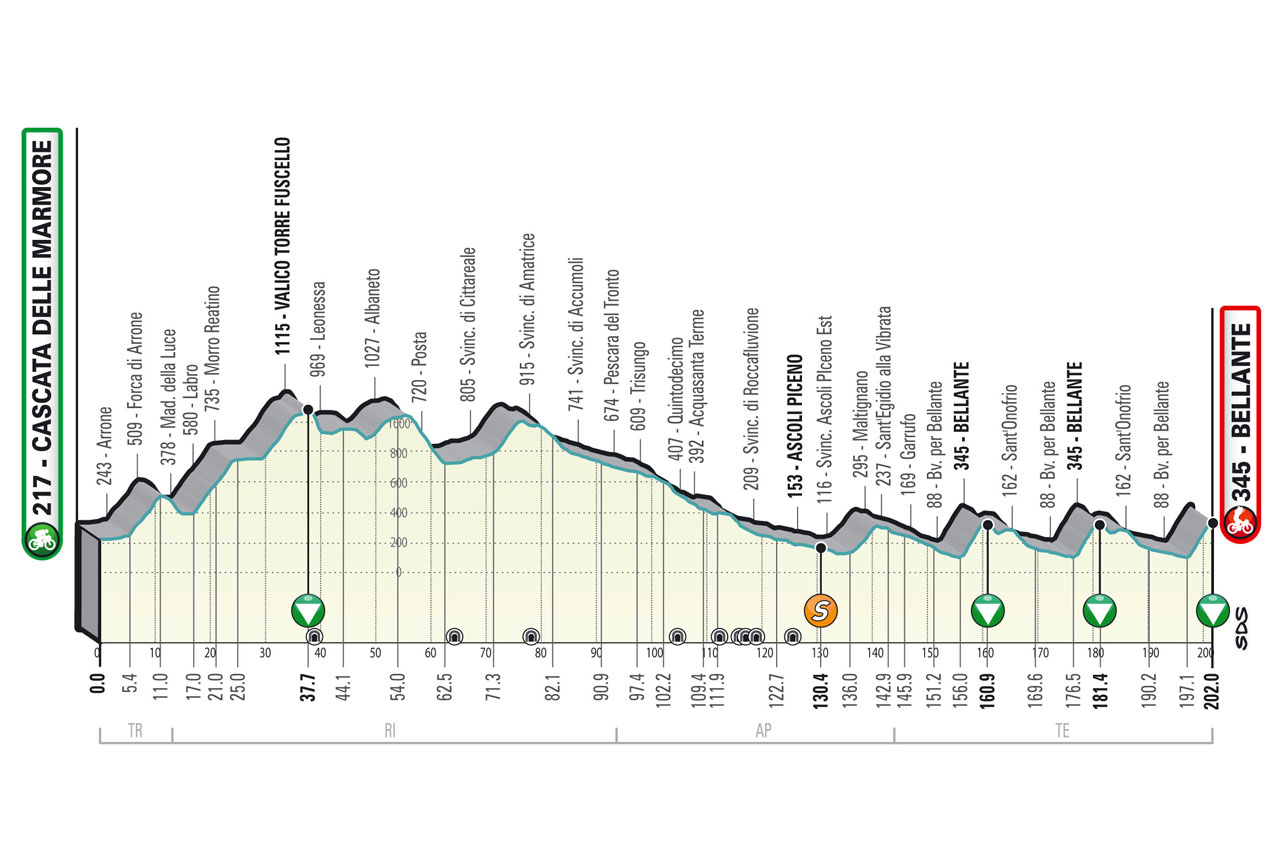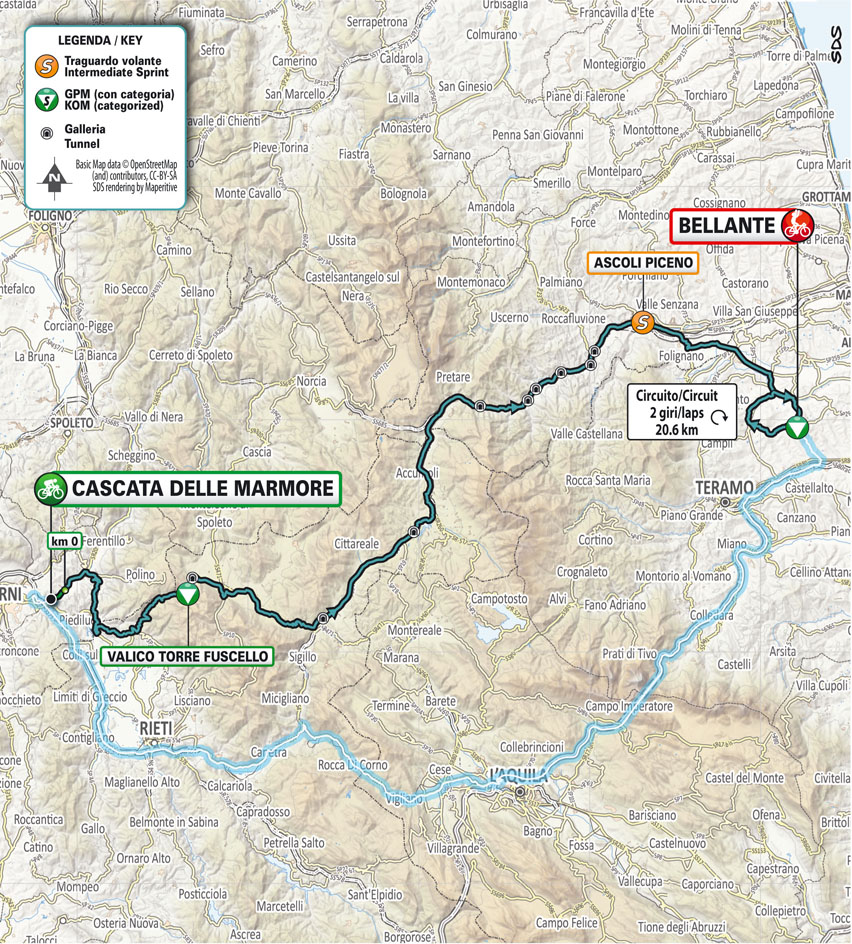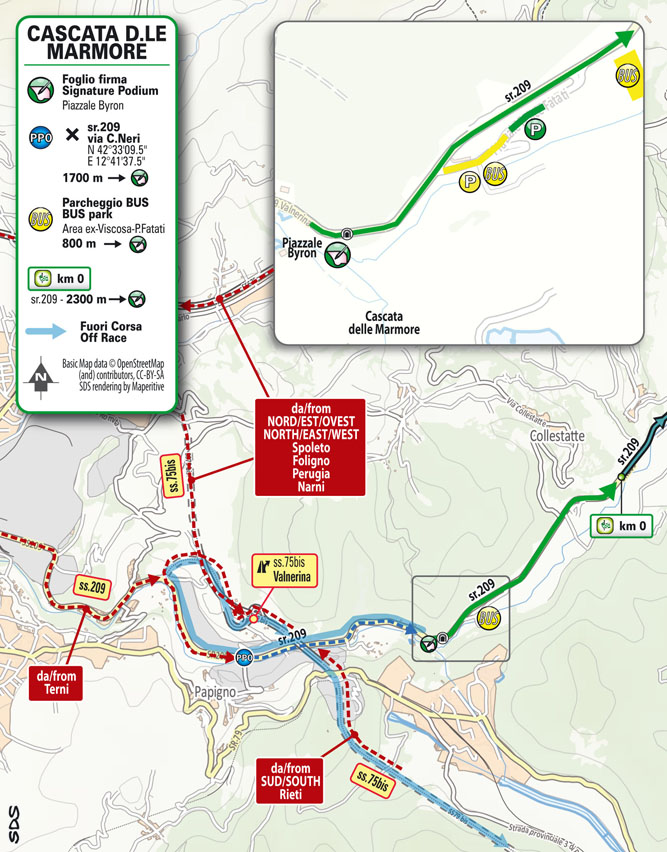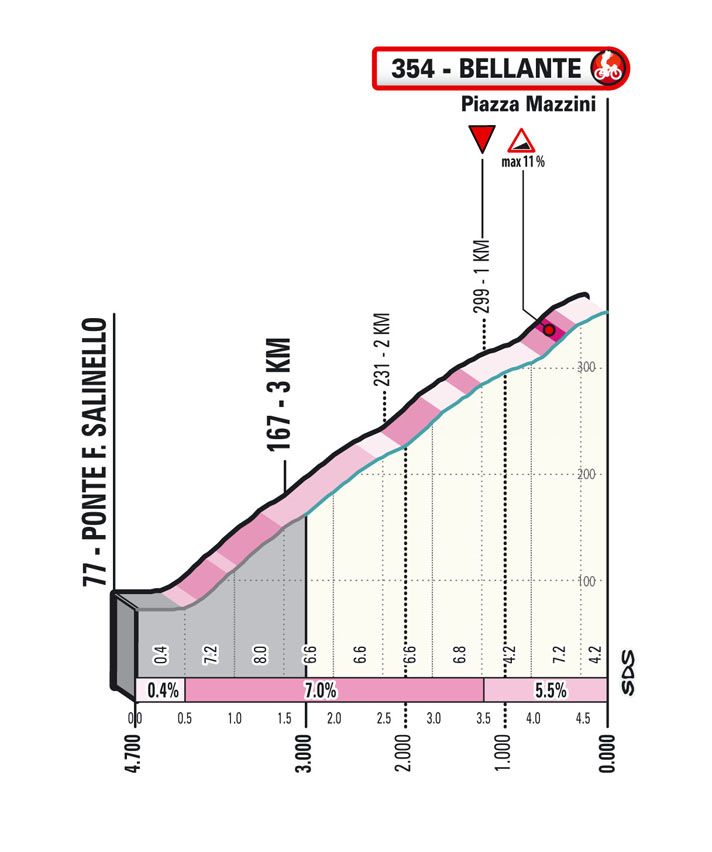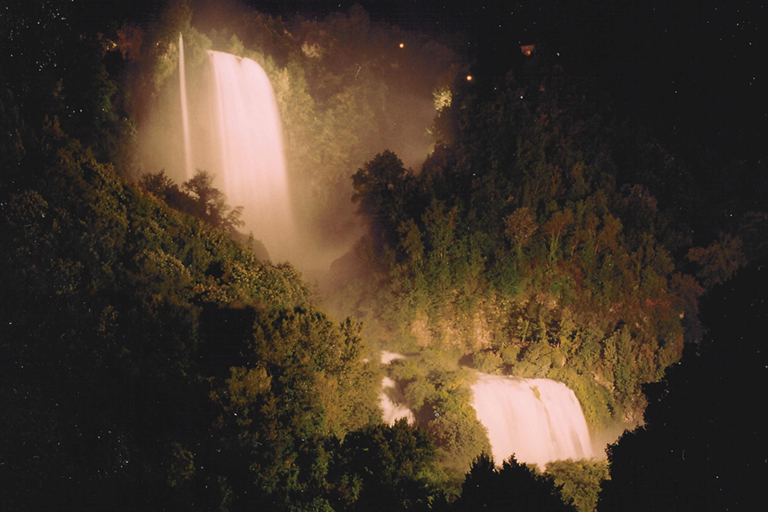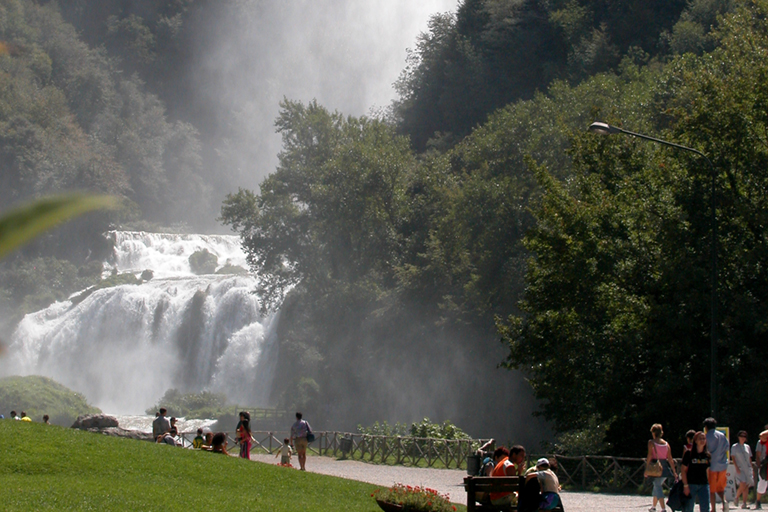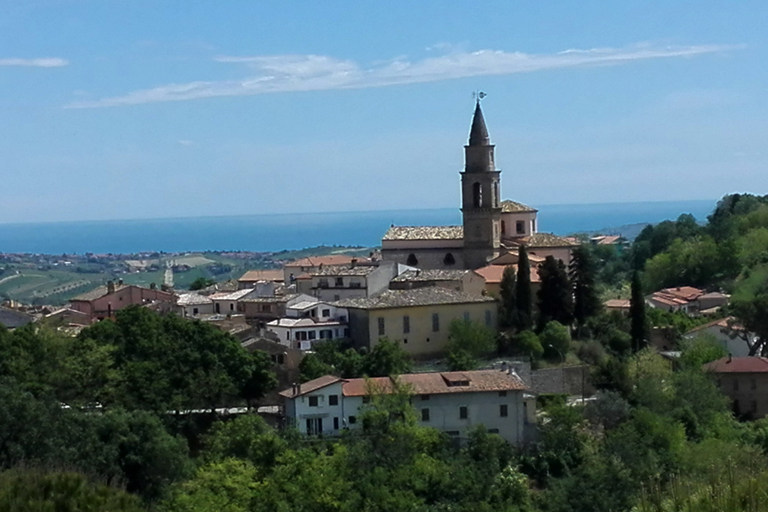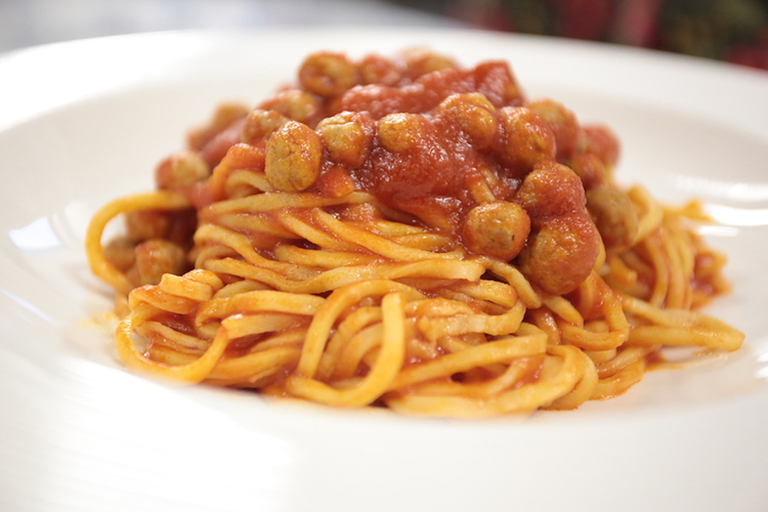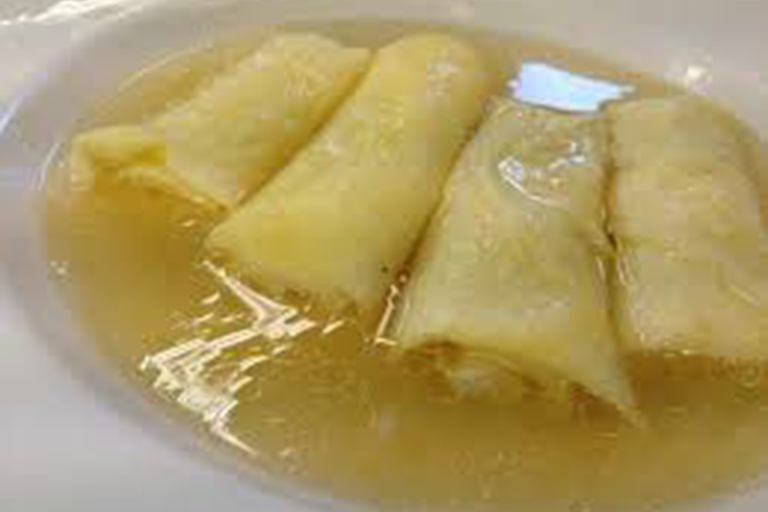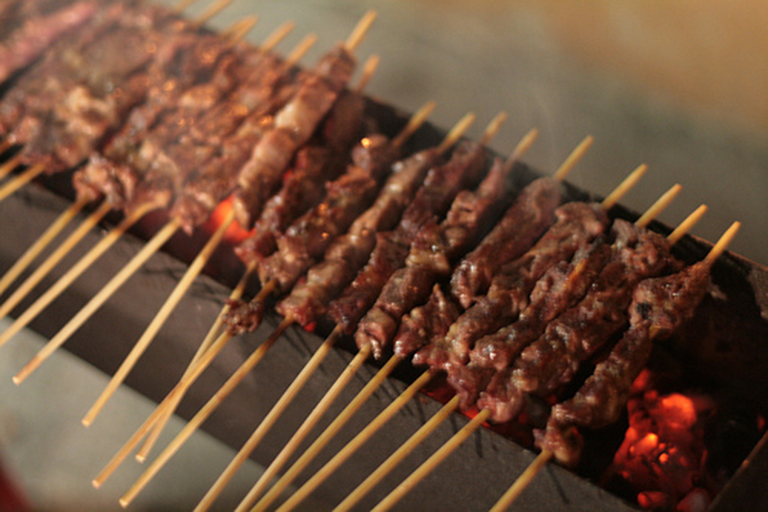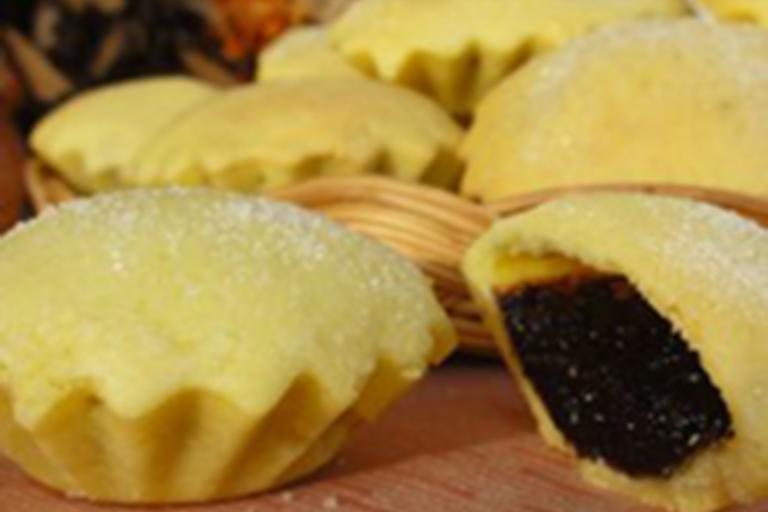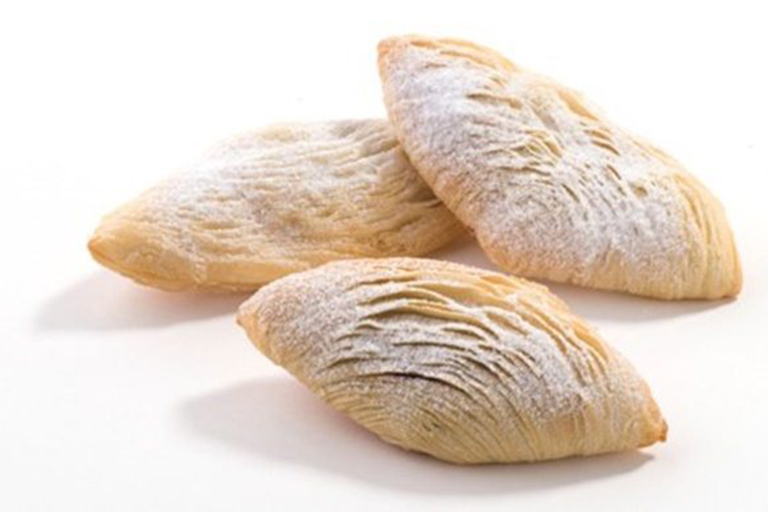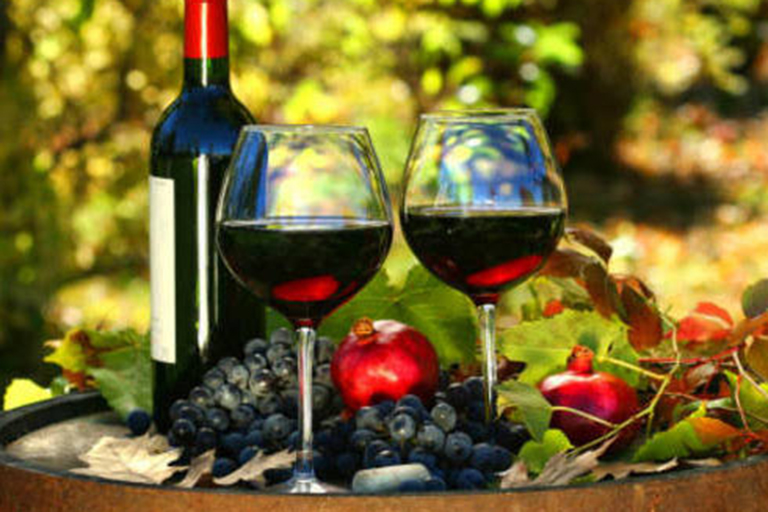profile
map
technical info
A stage that crosses the Apennines. From the Marmore Falls, the route climbs more or less continuously with reasonably gentle gradients to the Torre Fuscello pass before reaching Leonessa and taking the Via Salaria to Posta. After a brief ascent the Via Salaria winds gently downhill until it reaches Ascoli Piceno. A short climb to Maltignano follows, before entering the final circuit to be ridden twice after the first passage of the finish line.
Final Kilometers
The final kilometers take place on the circuit, along two complete laps. After Bellante, the riders will head downhill, with ups and downs to Sant’Onofrio where the road becomes wider and straighter. The road heads first towards the valley then parallel to the river before tackling the climb of about 3.8km that leads to the finish. Gradients here are in the region of 7% with peaks of 11%. Arrival on 7m wide tarmac.
start / finish
final kilometres
itinerary timetable
tourist info
Host city:
Cascata delle Marmore
Overview
The creation of the Falls dates back to271 AD and is an incredible work of Roman engineering, designed to favour the out flow of the Velino waters, responsible for frequent and disastrous flooding and transformation of extensive areas of land into unhealthy swamps. Afterwards, up to the Renaissance, further improvements were carried out until reaching its current form.
The great availability of water made the creation of numerous industrial sites possible in the area.
The area of the Falls is formed by travertine deposits, a naturally friable and non compact rock that, with the intense water circulation, favoured the formation of “karstic” cavities and caves.
The main cavities of speleogical interest as well as for the beauty and evocative power of the environment, are enclosed in three distinct complexes: the first includes the Grotta della Morta (Cave of Death)and the Grotta delle Diaclasi, and spreads over 287 m. with a maximum depth of 23 m.; the second is the Grotta delle Colonne (Cave of Columns), developed in two main parts, that afterwards collapsed forming two non-communicating environments; finally with a spread of over 190 m., theGrotta della Condotta, partly collapsed with an old water pipe passing through it.
The vegetation along the entire course of water is luxuriant and flourishing.
The area of the Falls features fine examples of willows, alders and holm oaks. The Aleppo pine often clings to the calcareous emergences of the slopes while the hill sides are covered with holm oaks, oaks, maples and beeches.
The Botanic Garden inside the Regional Nera River Park (2460 hectares) is well worth a visit where different plant life of the area can be admired.
There is an abundant water fauna. The woods are populated by several bird species such as the mountain swallow and redtail. The harrier eagle and kestrel are important examples of the birds of prey.
Bellante
Overview
Bellante is a municipality located on the hills of Teramo, in Abruzzo.
Besides the historical center, Bellante is divided into various districts including Ripattoni and Bellante Stazione, the latter being located at the southern end of the municipality in the part occupied by the Tordino valley bottom. Its position offers its visitors a magnificent view, from the blue of the Adriatic Sea to the green of the Teramo hills, ending with the snow-capped peaks of the Gran Sasso. The view from the Belvedere is extraordinary, from where you can sweep over the Montagna dei Fiori (Mountain of Flowers), the Monte dell’Ascensione in the area near Ascoli to the Adriatic and at the bottom the Salinello valley.
An ancient feud of the Acquaviva family, the town retains many traces of its medieval origins with finds from the Italic and Roman periods.
After being subject to Baron Attone Todino in the 12th century, it became the barony of Gualtieri di Bellante, who led an alliance of feudal lords against Charles II of Anjou. As for Ripattoni, its property was divided between Cicco di Acquaviva and Matteo di Canzano and in the 12th century it passed to the Acquaviva family until the 17th century.
Finally, Aurelio Saliceti (1804-1862) was born in Bellante.
Food
A land of transhumance, pastoralism and ancient traditions: Abruzzo has preserved intact the craft practices of the past, starting with the gastronomy. A rich and multifaceted cuisine divided between sea and land, mountain products, cheeses, cured meats and meats. Starting with first courses, one of the most representative specialties of Abruzzo and in particular of Bellante is SPAGHETTI ALLA CHITARRA, a type of pasta made in a beech wood frame (or another neutral wood) on which parallel steel wires are stretched. The square-section spaghettoni are then dressed with meat sauce, particularly the classic pallottine.
In addition, there are the so-called CRESPELLE or crepes which can be used for various preparations, including Scripelle ‘Mbusse, so called because they are rolled up and served in broth sprinkled with pecorino and parmesan cheese. The crespelle are also the basis for the preparation of the TIMBALLO, arranged in layers like a lasagna and stuffed with traditional sauces, and the CANNELLONI, rolled and stuffed and cooked in the oven.
PENNETTE ALLA BELLANTESE is the typical dish of Bellante, prepared with peas, mushrooms and minced meat combined in a single dish to create a harmonious whole.
ARROSTICINI are another symbolic product of the area, linked to the tradition of shepherding and based on small pieces of sheep meat skewered on a spit. According to the legend it was two shepherds who created the arrosticini, to recover the meat of the oldest sheep, otherwise inedible, cut into small pieces and barbecued on long wooden sticks.
As for desserts, the PIZZA DOLCE has long been a delicacy reserved for weddings and special occasions, whereas today it is prepared throughout the year. It is a cake composed of layers of sponge cake interspersed with classic and chocolate custard.
During Christmas time, typical sweets of Abruzzo and in particular of Bellante are the BOCCONOTTI, made of short pastry filled with grape jam and shaped like muffins. Always during the Christmas period, the CALCIONETTI and the SFOGLIATELLE (photo) are also present on the Abruzzo tables.
During the summer and winter periods Bellante organizes important gastronomic events that attract people from all over Abruzzo. Some of them are:
- SAGRA DELLE LUMACHE E TAGLIATELLE DI FARRO in June. The “strong” dishes of this gastronomic appointment are the Tagliatelle di Farro al sugo di lumache and the Pennette alla Bellantese. In addition, arrosticini, sandwiches with sausage, snails “in guazzetto”, fried cheese, pancakes – all accompanied by excellent wine and beer.
- SAGRA DELLA POLENTA in November, where dishes like Polenta with sausage sauce and pork ribs, white polenta with mushrooms, sausage and bacon – as well as other delicacies – are served.
Wines and beverage
As in the rest of Italy, wine-growing occupies a prestigious position among the agricultural activities of the region and the wines produced in the province of Teramo are known for their originality and quality. As Bellante is a hilly municipality, local producers have sought out the best positions for their vineyards to obtain grapes suitable to produce wines in line with the high standards of the province itself.
Among the most important wines is MONTEPULCIANO D’ABRUZZO COLLINE TERAMANE DOCG, an intense ruby red, robust wine that must undergo a minimum ageing period of at least 3 years, of which at least one year in wooden barrels and two months of refinement in the bottle. The aromas are those of red fruits and the wine’s nose is intense and ethereal. On the palate the taste is dry, rightly tannic, harmonious, and velvety.
Among the white wines our cellars produce the so-called TREBBIANO D’Abruzzo, a golden colored wine, dry and fruity, with a delicate bouquet and characterized by fresh acidity. We can also find PECORINO and PASSERINA, vines that give rise to fresh, structured wines and – especially if obtained from Pecorino – with excellent structure and alcoholic strength.
The cellars of the municipality of Bellante gather all the vastness of wines present in the province of Teramo, as well as CERASUOLO D’ABRUZZO, a cherry red wine with violet reflections, characterized by a fine and fruity bouquet with notes of morello cherry and strawberry. A wine that is harmonious, fresh and persistent.
Listed among the Traditional Agri-food Products by the Ministry of Agricultural Policies, GENZIANA and RATAFIA are two of the typical liqueurs of Abruzzo – being an extension of the typical products of this land rich in tradition.
Points of interest
The village of Bellante is of mediaeval origin and preserves a section of the ancient walls and the GATE TO THE BORGO, built in the 12th century.
Of great artistic and religious value is the PARISH CHURCH OF SANTA CROCE , with its Renaissance portal and high bell tower, which also serves as the ‘Civic Tower’. At its top stands an imposing and characteristic weather vane with the initials of the four cardinal points at the base and on the sides, on one side, the symbol of the cross, and on the other the town’s coat of arms with the inscription “Universitas Bellanti”. Inside the Rococo-style church you can find paintings by Nicolò Monti from Ascoli (Pompeo Batoni’s pupil), signed and dated 1793: a painting depicting the Epiphany from the school of Veronese and a silver Professional Cross attributed to Nicola da Guardiagrele (or in general to his school). Of great interest is also the CHAPEL OF SANTA MARIA DELLA MISERICORDIA on the left of the nave where there is the honorary Madonna and Child, a polychrome wooden statue from the 16th century.
Wandering through the narrow streets of the old town and admiring the ancient walls that surround it, in Borgo Bastione you can find PALAZZO TATTONI, a splendid early 20th-century building designed by Alfonso De Albentiis.
A walk along Corso Gualtieri takes you to Piazza Mazzini where the municipal headquarters are located.
A few more steps and you reach the Belvedere, where you can look out over the surrounding valley and the neighboring villages. To the right side of the Belvedere it is possible to stop in front of the MONUMENTO AI CADUTI della 2° guerra mondiale (MONUMENT TO THE FALLEN of the Second World War).
In the main town there are also the ruins of the ruined CONVENT OF THE CARMELITANS.
In the district of Ripattoni – which can be reached by following the old provincial road – we can admire PALAZZO SALICETI where Aurelio Saliceti was born. On the ground floor of the palace there’s the small municipal theatre and on the upper floors there are several rooms – richly frescoed with mythological and allegorical scenes, depicting classical divinities and the Four Seasons.
Near Palazzo Saliceti is PALAZZO MORUZZI, named after the family that bought it in 1975.
The most characteristic monument of the town – visible even from several kilometers away – is the ACQUAVIVA TOWER which, following the construction of the CHURCH OF SAN GIUSTINO, lost its military function, becoming a parish bell tower and, later, a municipal tower.
A much smaller tower – circular in plan, made of pebbles and apparently older – is located in the lower part of the village, on the southern slope, and is known as “il torrione”; in the same area a fragment of wall with an arched opening is visible, perhaps an ancient gate of the disappeared city walls.
Before leaving Ripattoni, a few kilometers further on, we must visit the CHURCH OF SANTA MARIA IN HERULIS, probably founded in the early Middle Ages and rebuilt and remodeled in the following centuries. Inside the single nave, with a trussed roof painted with geometric motifs, there are frescoes and stuccoes from various periods.
Since this year, the parish of Santa Croce and Santa Maria della Misericordia in Bellante Stazione has also been home to a relic from overseas belonging to the Venezuelan Blessed Dr. Josè Gregorio Hernàndez, a doctor who lived between the 19th and 20th centuries.


